

Most ebook files are in PDF format, so you can easily read them using various software such as Foxit Reader or directly on the Google Chrome browser.
Some ebook files are released by publishers in other formats such as .awz, .mobi, .epub, .fb2, etc. You may need to install specific software to read these formats on mobile/PC, such as Calibre.
Please read the tutorial at this link: https://ebookbell.com/faq
We offer FREE conversion to the popular formats you request; however, this may take some time. Therefore, right after payment, please email us, and we will try to provide the service as quickly as possible.
For some exceptional file formats or broken links (if any), please refrain from opening any disputes. Instead, email us first, and we will try to assist within a maximum of 6 hours.
EbookBell Team

5.0
80 reviewsBuild and train neural network models with high speed and flexibility in text, vision, and advanced analytics using PyTorch 1.x
Key FeaturesPyTorch is gaining the attention of deep learning researchers and data science professionals due to its accessibility and efficiency, along with the fact that it's more native to the Python way of development. This book will get you up and running with this cutting-edge deep learning library, effectively guiding you through implementing deep learning concepts.
In this second edition, you'll learn the fundamental aspects that power modern deep learning, and explore the new features of the PyTorch 1.x library. You'll understand how to solve real-world problems using CNNs, RNNs, and LSTMs, along with discovering state-of-the-art modern deep learning architectures, such as ResNet, DenseNet, and Inception. You'll then focus on applying neural networks to domains such as computer vision and NLP. Later chapters will demonstrate how to build, train, and scale a model with PyTorch and also cover complex neural networks such as GANs and autoencoders for producing text and images. In addition to this, you'll explore GPU computing and how it can be used to perform heavy computations. Finally, you'll learn how to work with deep learning-based architectures for transfer learning and reinforcement learning problems.
By the end of this book, you'll be able to confidently and easily implement deep learning applications in PyTorch.
What you will learnThis book is for data scientists and machine learning engineers looking to work with deep learning algorithms using PyTorch 1.x. You will also find this book useful if you want to migrate to PyTorch 1.x. Working knowledge of Python programming and some understanding of machine learning will be helpful.
Table of Contents